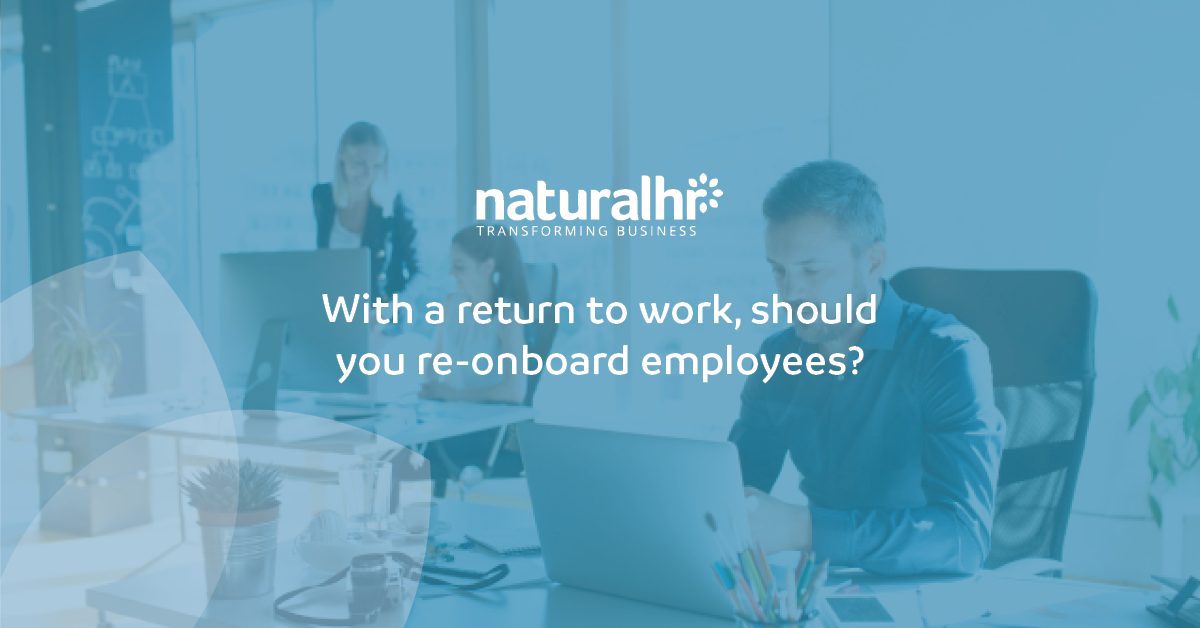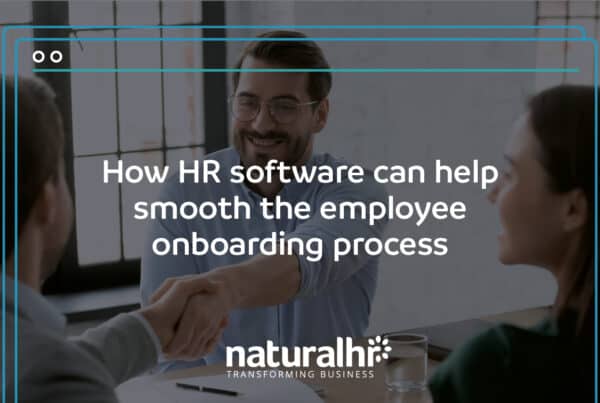
Onboarding is a broad term that captures many of the critical moments from the moment when your new candidate accepts their job offer from your business. Yet despite what COVID-19 has thrown at us, one common theme remains. Onboarding is the process that ensures your new starters are ready for whatever comes at them, whether they’re based at home or in the office.
But if your new starter joined your business virtually, and you’re planning on moving back to the office, should you consider re-onboarding them to an extent, or was your initial onboarding enough to support them, and your business?
In this article, we take a look at why you may want to consider re-onboarding your virtual starters when returning to the workplace, and how you may go around re-onboarding employees who started remotely.
Is it worth re-onboarding remote employees?
When the country shifted to working from home at the start of the COVID-19 pandemic in March 2020, employers were forced to switch entire elements of their business, including onboarding, to a virtual setting. But with more offices starting to see a return to work, albeit on a hybrid approach, should you consider re-onboarding the staff who began virtually over the past 24-months?
Re-onboarding and welcoming your staff back into the office will play a vital part in the success of your newer team as they grow and develop in your business, while also allowing your company’s social culture to flourish. Research from Glassdoor shows that organisations with strong onboarding practices improve employee retention by 82% and productivity by more than 70%.
The report highlighted that:
- Great employee onboarding can improve retention by 82%.
- Only 12% of polled employees think their onboarding was great.
- Most organisations only focus 1 week on onboarding.
One way to look at this question is from a legal perspective. If your new joiner is coming into the office for the first time, then they’ll need to be informed of building processes, from something as simple as what the fire procedure is, to where the first-aider sits, in case they’re required to fill in an accident form. Then there are other assessments you’ll need to perform, such as a Display Screen Equipment (DSE) assessment that will identify what improvements can be made to an employee’s workstation.
But then there are also the more personal elements to consider for new starters like security protocols (Do they need to be issued an ID badge?), conference room booking procedures, office rules (For instance, foods that are banned due to allergies), and even the more mundane things like where the tea and coffee making facilities and toilets are located.
Re-onboarding is not just about switching from your home routine and moving your staff back to the office; it’s also re-onboarding your company culture and the teams within it. The entire process should address, support and educate how your employees can reach out for support if they struggle to adjust to working back in the office. It should also cover topics such as requirements for returning to the office, how layouts and cleaning measures may have changed, and what your expectations are for how employees use common spaces.
But what are some common onboarding activities that could form part of your re-onboarding process?
6 onboarding activities that should be part of the re-onboarding experience
1. The dress code: If your staff have been working from home, you may have relaxed your dress code, but with staff returning to the office and beginning to undertake face-to-face meetings with clients, you may want to reintroduce the dress code to your new staff.
2. Defining the employees’ workstation: With both new and established staff coming back to the office, part of the re-onboarding process could include defining the employees’ workspace. Do they have a COVID secure place to work? Do they have all the equipment they need?
3. Order security cards and keys: With most offices having a secure entry system, do all of the pandemic new-starters have the required keys to get access? At this stage, you may also want to review your offboarding process: have you removed/collected these from all of the staff who have left during the office closure?
4. Face-to-Face introduction to the team: Perhaps the most missed perk of being based in the office, your re-onboarding experience offers a great opportunity to introduce your new staff members not only to their team but also to the wider company, including key figures such as management and health and safety officers.
5. Organising a work tour: This re-onboarding task can extend to both your new starters, but also your existing staff. If you’ve introduced social distancing elements to the workplace, you can use the tour to explain them to all of your staff, as well as introduce locations like meeting rooms, the kitchen and other shared spaces to new staff.
6. Review all policies, such as safety and security policies: Whilst some staff have joined your company, you may have also had some staff leave during the lockdown, so as part of your general re-onboarding, have you considered reviewing all of your policies from Fire Safety to Health and Safety? Do you still have enough trained staff on-site to cover your legal duties or do you need to invest in training for your staff?
How better onboarding can boost employee effectiveness
Onboarding is viewed by many as an essential business function. However, not all companies have an established onboarding process in place – and those that do are often dissatisfied with it. When you think of the primary goal of onboarding – to minimise the time of helping a new employee become effective – it’s a wonder some companies don’t take it more seriously.
A recent study by the Harvard Business Review found that 22% of companies had no formal onboarding programme, whilst 49% only rated their onboarding procedure as ‘somewhat successful’.
Yet it’s not just about the missed opportunity, as inefficient and ineffective onboarding can have a significant negative impact. In a survey of HR managers by job site CareerBuilder, 16% said poor or non-existent onboarding lowers their company’s productivity, 14% said it brings on greater inefficiencies, and 12% said it leads to higher employee turnover.
By contrast, successful onboarding has a positive effect – both in terms of productivity and employee retention. Research by the Aberdeen Group shows that organisations with a standard onboarding process experience 54% greater new hire productivity and 50% greater new hire retention. This was backed up further by a report from Korn Ferry stating that 98% of executives believed onboarding programmes to be key to employee retention.
Why are onboarding processes so inconsistent?
So why is the onboarding process so inconsistent across different companies? There are many possible reasons, but normally problems arise when it is left to managers to ‘design’ and run their own onboarding process. If they are unaware of the impact of poor onboarding, they won’t regard it as important.
Busy managers may de-prioritise the process, which results in a last-minute and haphazard approach, resulting in a poor experience for the new employee. Put yourself in the shoes of that new employee. Think no laptop, email, phone or even a desk on your first day. Your manager has booked a client meeting and is out of the office. Or your new team thought you weren’t due to start for another couple of weeks.
In recent years, HR has rightly stepped in to provide a more standardised framework to support managers. Even a basic onboarding checklist that ensures that the obvious things are done well can make a huge difference. First impressions count and a new employee is already feeling outside of their comfort zone when joining a new organisation, so it is a good opportunity to make them feel valued and part of the team.
How to re-onboard employees who started remotely
If onboarding is something you need to take seriously, here are our top tips to ensure your onboarding process really delivers – and where technology can help.
-
Start onboarding in advance
It’s a mistake to think that onboarding should only start when the new hire walks through the door. Actually, there’s plenty you can do in advance – such as setting up a system that automatically sends welcoming emails to newcomers and reminds them to bring necessary documents on their first day – security card, passport, driving license etc.
You can also share basic information about the company and planned onboarding activities for day one, and provide directions to the office.
In addition, you should talk to the new hire’s manager in advance, so he or she knows what’s expected of the incoming employee. You can also ensure your new hire’s workstation, and the devices they’ll need, are properly prepared. This initial preparation will smooth the path for your new employee and help them to hit the ground running.
-
Meet the team quickly
There’s nothing more dispiriting for a new employee than feeling lonely and disconnected at work, so it’s important to introduce your new hire to their team as soon as possible.
Don’t wait until you can get everyone in a room together, as that creates an unnecessary delay. Technology means that you can easily arrange a conference call or Skype meeting as soon as possible, so your new hire can start getting to know their colleagues quickly, maybe even before day one. Indeed, some new employees may attend an immersion day, prior to their official start date, to meet their new colleagues.
-
Make it a two-way process
There are likely to be multiple people involved in the onboarding process – the new employee, HR, line managers, team members, IT etc – so it makes sense to link everyone up on an electronic tool that enables collaboration and the sharing of information. You may also want to provide a checklist of onboarding tasks that need to be completed with an itinerary.
This type of collaborative approach allows you to set out exactly what needs to be done, when, and by whom. Then everyone – including your new starter – can be kept in the loop, as it’s easy to track progress and quickly fill any gaps.
An HR system can support this process and may enable you to gauge how a new employee is feeling through feedback mechanisms, such as a daily Pulse survey. You may decide to take this a step further and hold formal feedback sessions and set up an onboarding engagement survey. The feedback not only helps you monitor your new hires but will provide invaluable insights to help you further improve your onboarding programmes.
-
Track your training
Lots of information must be read and understood during the onboarding process, but is your new hire taking everything in?
One way of assessing this is through a training system, which periodically provides tests to assess your new employee’s level of comprehension, and automatically submits results for manager review. A comments field can allow the line manager to keep in touch with the new employee and offer feedback, whilst automated messages will remind both parties about upcoming face-to-face progress meetings.
After training is complete, some systems will calculate overall scores and provide a learning assessment to help with future development.
-
Manage information sensibly
It’s confusing and disorienting for any new starter to be presented with a huge amount of information on their first day. Equally, being left with little or no data on their role and requirements can make people feel unsettled.
You can avoid both scenarios by using technology to ensure the right details are sent at the right time – in easily digestible chunks. You could also set up a personal onboarding dashboard where information can be accessed when necessary – this could include employee handbook and company benefits information, as well as guides to using relevant software and equipment. You can release new information onto the dashboard as necessary, accompanied by email notifications.
Summary of onboarding new employees
Onboarding is a vital process for any business. Do it well and you significantly reduce the time it takes your new employee to start making the contribution you’ve hired them to make – boosting your business’ performance and in turn improving your chances of retaining them longer-term.
Do it badly, however, and you could end up with a disenfranchised and unproductive employee who is likely to leave their position quickly – saddling you with the expense and time of needing to hire someone else. To learn more about how to do it the right way, download our free guide.
Putting some time and effort into offering a standardised onboarding process can not only reduce costs but also have a major impact on productivity. Get in touch with us to ensure that your onboarding process is a success.





